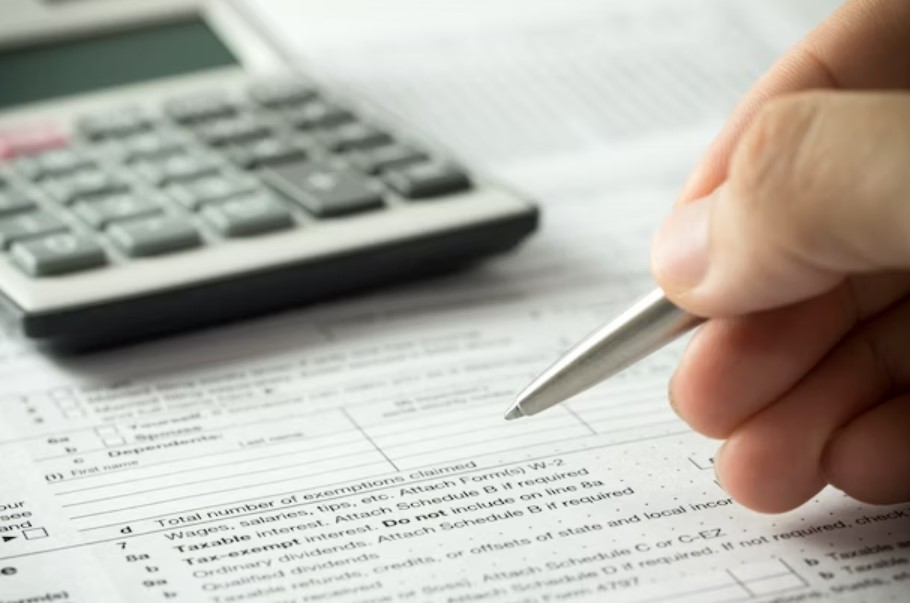When delving into How To Read A Business Tax Return? it’s essential to start with a foundational understanding. Business tax returns can seem daunting, but they provide invaluable insight into a company’s financial health. This guide offers a step-by-step approach to navigating and comprehending these complex documents.
Key Takeaways
- Identifying Sections: Recognize different parts of the tax return and their significance.
- Understanding Tax Forms: Differentiate between various IRS forms like 1040, and 1120.
- Analyzing Figures: Learn how to interpret the financial data presented.
- Spotting Red Flags: Identify potential issues or areas of concern.
How To Read A Business Tax Return?
Reading a business tax return thoroughly and understanding its components is essential for assessing a company’s financial health. Here’s a detailed guide to help you navigate through this process:

- Start with the Basics: Identifying Information
- Begin by reviewing the basic information on the tax return. This includes the business name, address, tax identification number (EIN), and the tax year. This section sets the stage for the rest of the document.
- Understand the Business Structure
- Identify the type of business entity (sole proprietorship, partnership, corporation, S corporation, LLC, etc.) as this determines the form used (e.g., 1040 Schedule C for sole proprietors, 1065 for partnerships, 1120 for corporations).
- Examine Income Details
- Look at the income section of the return. This will show the gross receipts or sales and other income. Analyzing this section provides insight into the primary revenue sources of the business.
- Review Cost of Goods Sold (if applicable)
- If the business sells products, there will be a section for the cost of goods sold. This includes inventory costs and is deducted from gross receipts to arrive at the gross profit.
- Analyze Deductions and Expenses
- Scrutinize the deductions and expenses. This includes operating expenses like rent, utilities, salaries, and other business-related expenses. These are subtracted from the gross profit to determine the net business income or loss.
- Check for Depreciation and Amortization
- Review the depreciation and amortization schedules if the business owns any significant assets. This can affect the net income and provide insights into asset management strategies.
- Look at Tax Credits and Deductions
- Identify any tax credits or special deductions claimed. These can include credits for research and development, energy efficiency, or other specific activities.
- Assess Net Income and Tax Liability
- The bottom line of the main form shows the net income and total tax liability. This gives an idea of the business’s profitability and the taxes owed or refund due.
- Review Balance Sheet (for Corporations)
- If reviewing a corporate tax return (Form 1120), examine the balance sheet section. It lists the company’s assets, liabilities, and equity at year-end and is crucial for understanding the company’s financial position.
- Analyze Schedules and Additional Forms
- Go through any additional schedules and forms attached. Each schedule can provide more detailed information on specific areas, such as a detailed breakdown of expenses or information on foreign transactions.
- Read Notes to Financial Statements
- If available, review the notes to the financial statements. These notes can offer valuable context and explanations for the numbers on the tax return.
- Compare Year-to-Year Data
- If possible, compare the current tax return with those from previous years. This comparison can reveal trends, growth patterns, or areas of concern.
- Correlate with Other Financial Statements
- Finally, compare the tax return data with other financial statements like the income statement and balance sheet. This helps validate the accuracy of the tax return and provides a comprehensive view of the company’s financial health.
Each step in this process is crucial for a thorough understanding of a business tax return. It’s not just about the numbers, but also about the story they tell regarding the financial performance and stability of a business.
Understanding the Structure of a Business Tax Return
A business tax return typically comprises several sections, each serving a unique purpose. The first part usually includes basic information about the business, like its name, address, and tax identification number. This is followed by financial summaries, detailing the company’s income, deductions, and tax liability.
Key Components of the Financial Summary
In this section, businesses report their total income, cost of goods sold, and gross profit. Operating expenses, such as salaries and rent, are then deducted to calculate the taxable income.
Analyzing Income and Deductions
Understanding income and deductions is critical for accurate tax assessment. Revenue streams are listed alongside various deductions, giving a clear picture of the company’s net income.
Breaking Down Different Tax Forms
Business tax returns vary based on the company’s structure. For example, Form 1040 is used by sole proprietors, while corporations use Form 1120.

Sole Proprietorships and Form 1040
Sole proprietors report business income and expenses on Schedule C of Form 1040. This form details the company’s profit or loss.
Corporations and Form 1120
Corporations file Form 1120, which requires detailed financial data. This includes income statements, balance sheets, and other relevant financial information.
Interpreting Financial Data
Financial data in tax returns is a goldmine of information. It reveals the company’s profitability, efficiency, and overall financial health.
Understanding Revenue and Profit Margins
Revenue figures indicate the business’s earning capacity. Analyzing these alongside profit margins offers insights into operational efficiency.
Assessing Expenses and Deductions
Expenses and deductions reflect the cost of running the business. Understanding these helps in evaluating the company’s spending patterns and potential areas for cost-saving.
Spotting Red Flags
Tax returns can also highlight potential issues. Discrepancies in reported income, unusual deductions, or inconsistencies with previous years’ data warrant further investigation.
Identifying Unusual Patterns
Sudden changes in income or expenses, or significant deviations from industry norms, can be red flags.
Cross-Referencing with Financial Statements
Comparing tax return data with internal financial statements helps verify accuracy and consistency.
Evaluating Asset and Liability Information
A critical part of a business tax return is the information related to assets and liabilities. This section offers insights into the financial stability and long-term viability of a business.

Interpreting the Balance Sheet
The balance sheet on a tax return showcases the company’s assets, liabilities, and shareholder equity. Understanding how these elements balance out provides a snapshot of the company’s financial health at a particular point in time.
Assessing Long-term Financial Health
Long-term assets, like property and equipment, indicate investments for future growth. Similarly, long-term liabilities, such as loans and mortgages, give an idea of the company’s debt structure. Analyzing these figures helps assess the business’s long-term financial stability and risk profile.
Deciphering Tax Credits and Deductions
Tax credits and deductions can significantly impact a company’s tax liability. Understanding how these are applied to the tax return is crucial for an accurate assessment of the company’s tax obligations.
Understanding Tax Credits
Tax credits are direct reductions in tax liability and can come from various sources, such as investments in certain areas or activities. Identifying these credits on the tax return can provide insights into the company’s strategic investments and opportunities for tax savings.
Analyzing Deductions
Deductions reduce taxable income and can include expenses like business travel, office supplies, and depreciation. A detailed analysis of these deductions can reveal spending patterns and potential areas for cost efficiency.
Comprehending Depreciation and Amortization
Depreciation and amortization are methods of allocating the cost of tangible and intangible assets over their useful lives. These concepts are critical in understanding how a business manages its long-term assets.

The Role of Depreciation
Depreciation is applied to physical assets like machinery and buildings. It reflects the wearing out of these assets over time. On the tax return, depreciation affects both the value of assets and the taxable income.
Understanding Amortization
Amortization is similar to depreciation but applies to intangible assets like patents and trademarks. Recognizing how amortization is reflected on the tax return helps in understanding the value and impact of intangible assets on the business’s finances.
Businesses may report losses that can significantly affect their tax situation. Understanding how these losses are treated and carried forward is essential for a full picture of the company’s financial trajectory.
Handling Business Losses
Losses can occur in any business and are often reflected in the tax return. Analyzing these losses helps in understanding the challenges the business might be facing and its overall financial health.
Carryforward Provisions
Tax laws allow businesses to carry forward losses to offset future profits. This provision can impact future tax liabilities and is an important aspect to consider when reviewing a tax return.
Conclusion
In summary, reading a business tax return effectively requires understanding its structure, recognizing different forms, interpreting financial data, and spotting potential red flags. This knowledge is vital for making informed financial decisions and ensuring compliance with tax regulations.
Frequently Asked Questions
What red flags should I look for when reviewing a business tax return?
Red flags include significant year-to-year variations in income or expenses without clear explanations, unusually high deductions compared to industry norms, and inconsistencies between the tax return and other financial statements. These could indicate errors, financial instability, or even potential fraud.
How do carryforward losses work on a business tax return?
Carryforward losses allow a business to use current losses to offset future profits, reducing future tax liabilities. The rules and limits for carryforwards vary, so it’s important to understand the specific tax laws applicable to the business.
Is it possible to determine a company’s cash flow from its tax return?
While a tax return doesn’t directly provide cash flow information, it can offer clues. For instance, discrepancies between reported income and taxable income can be due to non-cash expenses like depreciation. For a clearer picture, however, a cash flow statement is more direct and informative.
How can depreciation and amortization affect a company’s taxable income?
Depreciation (for tangible assets) and amortization (for intangible assets) reduce the company’s taxable income by spreading the cost of an asset over its useful life. This accounting practice lowers the reported annual income, thereby reducing the tax burden.
A multifaceted professional, Muhammad Daim seamlessly blends his expertise as an accountant at a local agency with his prowess in digital marketing. With a keen eye for financial details and a modern approach to online strategies, Daim offers invaluable financial advice rooted in years of experience. His unique combination of skills positions him at the intersection of traditional finance and the evolving digital landscape, making him a sought-after expert in both domains. Whether it’s navigating the intricacies of financial statements or crafting impactful digital marketing campaigns, Daim’s holistic approach ensures that his clients receive comprehensive solutions tailored to their needs.









